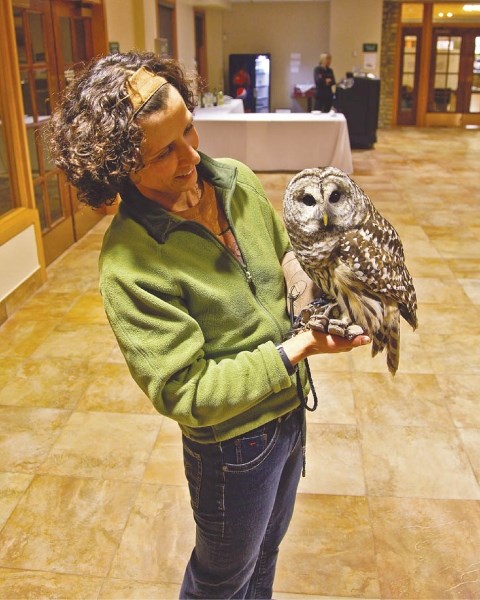In the second part of the MD of Bighorn’s Living in the Natural Environment Speaker Series, Gordon Court, Provincial Wildlife Status Biologist with Alberta Fish and Wildlife, brought his considerable knowledge of owls and their behaviour to the Cochrane RancheHouse on Friday (Feb 4).
Owls, Owlers and Owling – The Silent Predator and Our Obsession with Them, was an engaging look at the elusive nocturnal predator and the habitats they need in order to survive. Owls, in addition to being photogenic, are also good indicator species for the overall health of the environment.
“While some species of owls are more difficult to study than others, they certainly can be indicators of good stewardship,” Court said after his slideshow presentation.
“Say you’re trying to do good forest management to keep biodiversity of landscape; well you’re going to find if you lose Barred owls right away, then you know you screwed up. You haven’t retained something on the landscape they needed.”
With 13 species of owls present in Alberta, including three (Great Grey, Boreal, and Northern Hawk) that are in the top 10 ‘want to see’ category for many bird enthusiasts, most Alberta habitats will have an owl presence.
“A lot of owls (in Alberta) are pretty much grassland obligate species, the Burrowing owl and Short Eared owl for example, and they would also be indicators that you’re doing something right on the landscape, as they’re quite easy to lose on the landscape too.”
A highlight of the evening’s event was undoubtedly Colonel Slade, a tame Barred owl, which, because of partial blindness, can never be returned to the wild and now serves as an ambassador for owls during Court’s presentations.
Accustomed to humans, Colonel Slade perched patiently near the screen during the slideshow, and helps Court explain the physiology and habits of owls, while deepening the general curiosity and respect humans have for the animals.
That interest will be crucial to conservation efforts, which include population monitoring and banding, private woodland conservation, and a better understanding of habitat needs in Forest Management Plans.
“Species of special concern is a designation that we use,” Court said. “We run the owls through an assessment to see whether or not they could possibly be endangered or threatened. Species of special concern is an indication that they have specific requirements and if we don’t do something purposefully to keep them on the landscape, they might become threatened or endangered. We give them that designation to give people a heads up.”
In certain regions it is clear that habitat must be well managed if Albertans want to keep all current owl species on the landscape.
“When you talk to people here (tonight), and many of them are land owners or people who work the land or choose to live outside the city, you find it’s quality of life for them to see some of these owls. They want to have Great Grey Owls in Water Valley and they want to be able to see them.
“They live out there for a reason, and one of the reasons is owls. Owls are signs of the wilderness, so there’s an emotional reason for having them, and then again they are also indicators of a healthy environment.”
Earlier in the evening, Dr. Ross McKenzie presented Urbanization and Loss of Prime Agricultural Land - It’s Not Just a Rural Issue, and Reeve Dene Cooper, who hosted the event for the MD of Bighorn, expressed his appreciation for both lectures, and thanked both presenters for making their considerable expertise available to all the surrounding communities.
“I think we have many of the same concerns, in part because we have similar landscapes. If you go to Clearwater for instance, I would say the Clearwater landscape and the Ranchlands landscape to the south are eastern slopes landscapes and the issues they’re facing are almost identical to the issues we’re facing.
“When you get out onto the agricultural lands in Rocky View and Foothills and Mountain View, they have more cropping agriculture. But even in ranching agriculture versus cropping agriculture, there are more underlying concerns than there are differences.
“It’s the landscape, the water, the air, the soil and biodiversity that is bringing these people to a common conversation,” Cooper said.
For more information on owls, as well as biodiversity and stewardship on Alberta’s lands, visit www.srd.alberta.ca




